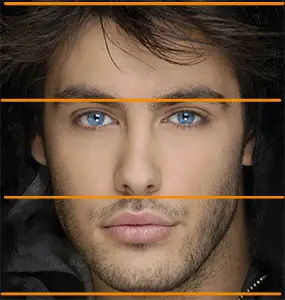
Several face ratios can quantify facial attractiveness. An example is the midface ratio. It considers how compact and ideal a person’s midface is related to the other parts of the face. A strong midface ratio can be an excellent indication that you have an objectively attractive face.
You can obtain your midface ratio by dividing your interpupillary distance (IPD) by the vertical distance from your pupil’s center to the top of your lip. The ideal midface ratio should be around 1 to 1.1. Any less than 0.9 lacks the right proportions. If too high, you develop an uncanny look.

The midface ratio is important because nobody likes a long face. The metric is all about determining whether the midface is appropriately short or if it is too long. Think of the metric as a box right in the middle of the face. Even though the measurement considers the pupils and the lips, what is inside the box is the most important.
Ideally, the box’s horizontal lines should be just a little bit longer than the vertical ones. This ratio is ideal because any less than 1.00 would mean that your nose and philtrum length is longer than interpupillary distance. As you can imagine, that will not look good in most scenarios.
Consider one of our custom facial reports if you’re interested in an in-depth analysis of your midface.
Interpupillary Distance
The interpupillary distance (IPD) is not the distance between your eyes. Instead, interpupillary distance is the distance from your left pupil’s center to your right pupil’s center. This line should be measured when you are looking straight ahead for it to be accurate.
The interpupillary distance is not only used in aesthetics but eyesight correction as well. Research by Murray et al. (2017) has found that IPD is a reliably good metric compared to other measurement methods. Many experts consider IPD when giving vision correction tools such as glasses. The IPD allows for the proper placement of the lens to facilitate maximum assistance.
For aesthetics, the purpose it serves is to measure the width. You want a face that is moderately wide and not too long.

Vertical Distance
Before you attempt this measurement, make sure that the image you are working with is as frontal as possible. This precaution is to eliminate any odd angles and skewing.
First off, draw a straight horizontal line sitting right on the tip of your upper lip. This part is usually the highest part of your cupid’s bow. Next, take note of the center of your pupils. Draw a vertical line from the center of your pupils down to the horizontal line you just made. The lines should be parallel to each other and perpendicular to the horizontal line. Any angles will mess up the ratio, and it will not give an accurate result.
In contrast with the IPD, the vertical distance is for measuring midface length. This distance includes the length of the philtrum and the nose, which we will get to in the next section. Predictably, a long vertical distance is what you want to avoid.
Components of the Midface
Now that we have touched on the ratio requirements, we can discuss what components are in the midface and what the ratio is for in practice.
Philtrum
The philtrum is the space right beneath your nostril and just before your lip starts. The average philtrum is around 14-15mm. Males should have longer philtrums than females.
A long philtrum is usually undesirable because it gives off the impression of a long face. Conversely, a long face is something usually associated with mouth breathing.
However, the philtrum is not the most important aspect. Usually, it plays little part in the ultimate scheme of things. For example, there are still people who can look good with a long philtrum. Think about the likes of Brad Pitt and Ian Somerhalder. These celebrities both have longer than average philtrums. Yet, they look distinctly attractive.

Nose
The nose is the more telling component. The nose is much more prominent than the philtrum. This prominence is why it affects the overall midface ratio more. Take a look at this photo of Adam Driver. You’ll see that his nose is long, which contributes to his long face.

A long nose coupled with close-set eyes is a recipe for disaster. Both of those characteristics in one face are bound to look unattractive.
The Ideal Midface Ratio
As previously mentioned, the ideal midface ratio is around 1.1 or above. A ratio of 1 is also passable. However, any less than 0.9 will look bad. A classic example of an ideal midface ratio is Sean O’Pry. He has the ideal midface that is compact and does not have any unnecessary length to it.

Facial Thirds
Facial thirds are another way of evaluating the midface. Unlike the midface ratio, facial thirds don’t take the philtrum into account.

Generally, most humans don’t fit perfectly into facial thirds, especially men who tend to have larger lower thirds. However, the length of the middle third is still a good gauge of midface length. Technically, the middle third is the “true” midface, but a long philtrum can make a face look much longer than it really, even if the middle third is of a normal length, which is why we also use the midface ratio.

